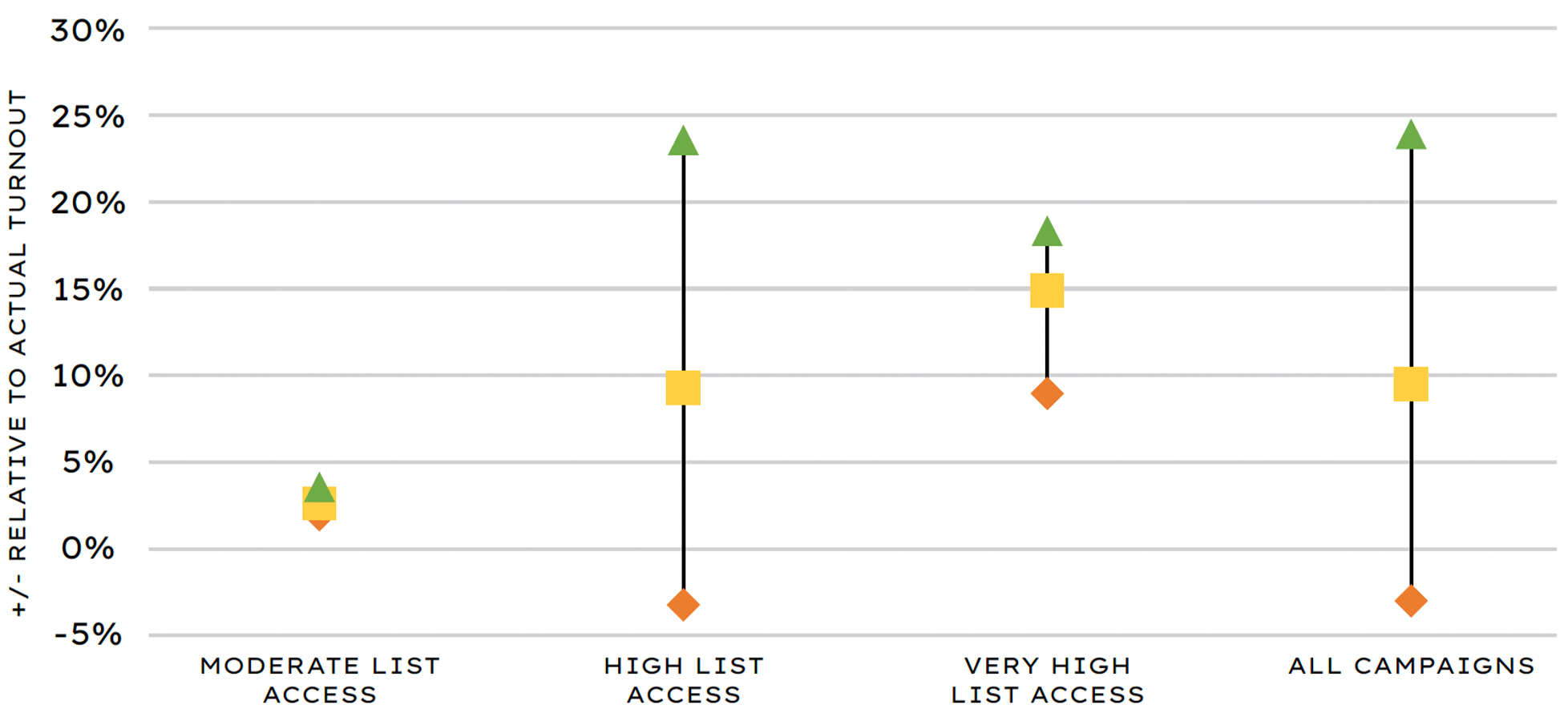INTRODUCTION
At P.A.C.E., we are partners in advocacy, communications and engagement. We believe in an America where every family can access a great education and participate fully in our democracy. We partner with local leaders across the country to run advocacy, communications, and engagement campaigns anchored in the foundational beliefs that schools are the bedrock of strong communities and that everyone’s voice deserves to be heard in our democracy.
Since our founding in 2018, we have refined a strategy to increase voter turnout in communities of low-propensity voters who are unlikely to have been targeted by other campaigns. On average, across more than a dozen election efforts, we’ve increased turnout within our target universes by 11 points.
This 11 point increase from the expected to actual turnout represents nearly 10,000 more voters turning out than numbers forecast by the voter turnout model.
The elections we are most focused on amplifying community voices in are local elections for offices like the Board of Education or City Council. Turnout is, unsurprisingly, very low in these elections compared with statewide and presidential races.
But with the right level of tactical engagement, we have demonstrated that it is possible to develop a voting bloc that we can rely on to turn out and vote in every contest – from presidential elections to off-year municipal and hyper-local races.
We think about our voter participation work in three phases: 1) voter registration, 2) voter commitment, 3) and voter turnout. Once we’ve established baselines for phases 1 and 2 using historical data, we align with our partner on a suite of tactics and a set of core messages that align with their goals and local context. Our full set of tactics includes emails, text messages, social media posts, direct mail, phone banking, IVR calls, robocalls, canvassing, and robust digital ad campaigns and is grounded in the idea that the partner organization is viewed as a recognized, credible messenger.
It’s critical to note that our voter participation work with partners hinges on obtaining high-level access to a list of their community members, constituents, in the case of schools – their families. Our most successful voter participation partnership are whens, we’re given full access to a partner’s list that includes the first name, last name, phone number, and address of adult constituents. With that access, we can match the list to a voter file and develop a dataset to track for voter registration and turnout rates.
This report presents a retrospective meta-analysis engaging data compiled and analyzed during and subsequent to voter participation campaigns conducted by P.A.C.E. in support of local organizations in four states.
Following the table of contents directly below, the document narrates greater detail regarding the aims of the analysis, in preface to a sampling of its key findings. A methodology follows, with subsequent body sections exploring the data in greater detail. Appendix charts appear in the final portion of the report, showing the complete distribution of voter participation results disaggregated by key variables.
STATEMENT OF PURPOSE & KEY FINDINGS
Since 2018, P.A.C.E. has supported dozens of nonpartisan, nonpolitical partner voter participation campaigns in more than half a dozen states. The aim of this report is to take a retrospective look at a representative sample of these campaigns and interrogate three key questions:
- How does turnout in P.A.C.E.’s voter participation universe compare to overall local turnout?
- How does turnout in P.A.C.E.’s voter participation universe compare to the universe’s expected turnout?
- Are there campaign variables that appear to clearly correlate with turnout deltas within the universe?
- What is the size of the universe analyzed to measure P.A.C.E.’s impact?
Following the key findings directly below, the report presents a methodology and then dives into detailed turnout comparisons and an exploration of whether specific variables appear to correlate with trends within the data.
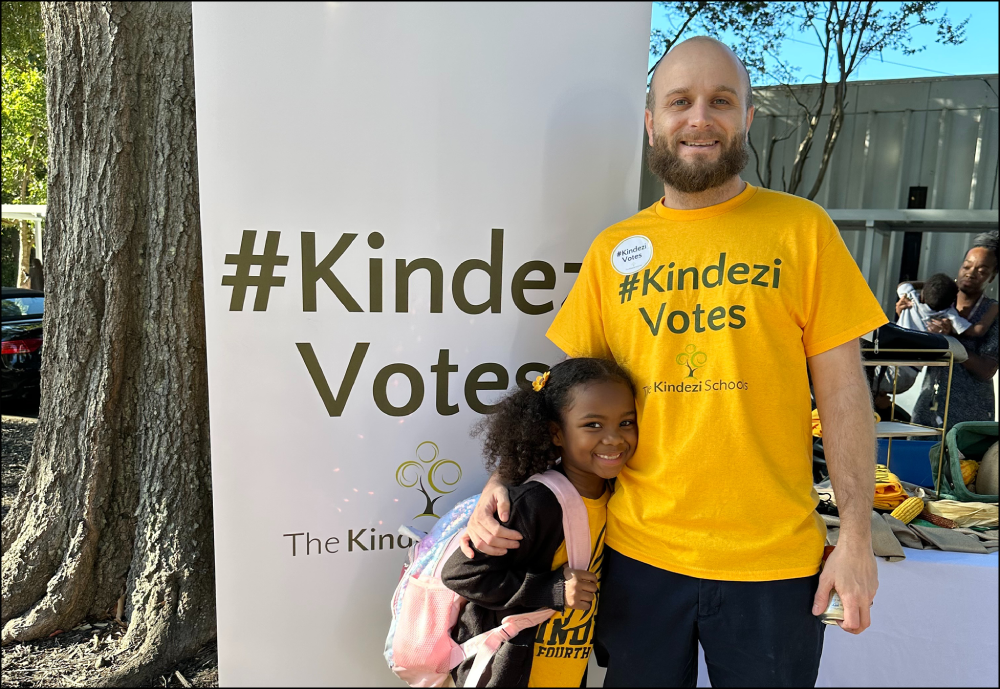
KEY FINDINGS
Within P.A.C.E.’s universe of voter participation campaigns, 13 campaigns targeting a total of 80,987 registered voters satisfied the criteria for inclusion in this meta-analysis. In this universe of targeted registered voters:
- Voters targeted with participation tactics turned out at higher rates than other voters in the same elections (that is, exceeded overall local turnout) in 12 of the 13 campaigns – on average, by 10 points.
- Voters targeted with voter participation tactics outperformed their expected turnout, which predicts turnout likelihood based on each individual’s unique characteristics, in 13 of the 13 campaigns – on average, by 11 points.
- The overall turnout advantage among voters targeted with participation tactics tended to trend from smaller to larger in alignment with two variables: campaign level (e.g. the breadth of tactics deployed) and campaign access to contact lists.
» “Moderate” level campaigns with fewer tactics deployed had more modest turnout advantages (+1.5 points on average) than “high” level campaigns (+13.1 points on average).
» Greater access to contact lists was associated with larger turnout advantages, with “moderate access” returning a +2.6 point advantage, “high access” returning a +9.0 point advantage, and “very high access” returning a +15.0 point advantage.
These results show a much larger “treatment effect” than has been demonstrated in many large sample size studies or randomized control trials (RCTs) designed to measure the impact of voter participation tactics.
While we cannot prove this without a true RCT that could isolate specific variables and tactics, our hypothesis is that when you combine a broad suite of voter engagement tactics with a trusted messenger like a child’s school and target these tactics toward a targeted universe of voters, including those who are unlikely to be engaged by traditional campaigns, you can produce an outsized impact on turnout.
We believe that our retrospective data shows that combining these tactics can produce an outsized impact on voter turnout.
METHODOLOGICAL NOTES
The section below narrates methodological notes regarding the selection of campaigns for inclusion in this meta-analysis and discusses extraneous variables that could not be controlled for within the sample.
INCLUSION CRITERIA
The campaigns comprising the universe of reviewed data were not conducted with the intent of comparing their outcomes in the future. Instead, each campaign was designed and executed on a bespoke basis, incorporating local priorities and strategy. As an unavoidable result, it is not methodologically possible to fully normalize the sample into a streamlined apples-to-apples universe.
Nonetheless, it is both necessary and possible to install certain inclusion and exclusion criteria in a retrospective meta-analysis – most significantly, with regard to the breadth of tactics deployed and the campaign’s access to necessary contact information.
These filters, bulleted in greater detail below, returned a universe of 13 comparable campaigns that 1) were designated either “moderate level” or “high level” based on the breadth of tactics deployed and 2) enjoyed “moderate” to “very high” access to contact information for the target universe.
Campaign level.
The analysis includes four campaigns designated “moderate level” (deploying promoted digital, email, mail pieces, and phone calls) and nine campaigns designated “high level” (deploying “moderate level” tactics with the addition of on-the-ground organizers or stipend advocates).
Access to contact lists.
The analysis includes campaigns that had access to at least 40% of the target universe’s contact information. This range is additionally segmented into three tiers: moderate access (40 – 60% access), with two campaigns; high access (61 – 80% access), with eight campaigns; and very high access (81 – 100% access), with three campaigns.
Defining Expected Turnout
To estimate expected turnout for the universe of voters targeted, a methodology was crafted using election- and voter-specific data sources. These sources are reflected in the Expected Turnout Score Formula defined below:
[The mean local voter score for the target universe (“MU”)] divided by [the mean local voter score for the city (“MC”)] multiplied by [the actual turnout for the city (“AC”)]
OR
MU/MC x AC.
In simple terms – the formula applies the ratio of the target universe’s predictive voter score and the target city’s predictive voter score to each election’s actual turnout rate. When tested against historical data, this methodology generated a tight margin of error in the aggregate and did not consistently overpredict or underpredict turnout.
TURNOUT + / – TRENDS REVIEWED AGAINST OTHER VARIABLES
Having established that the campaign universe outperformed both actual local turnout and expected turnout within the sample, it next merits examining whether any correlations seem to exist between these + / -’s and 1) whether a campaign was “moderate” or “high” level and 2) whether a campaign had “moderate,” “high,” or “very high” access to contact lists.
In theory, one could reasonably expect that campaigns of a higher level (e.g. more tactics deployed) would tend to generate larger value adds than campaigns of a lower level. Similarly, one might expect that campaigns with greater access to contact lists would tend to generate larger value adds than campaigns with less access.
A review of the data tracks with these expectations: higher level campaigns generated larger average turnout advantages, as did campaigns with greater access to contact lists. The tables and charts below present key metrics for the 13-campaign universe disaggregated by campaign level (the first table and chart) and list access (the second table and chart).
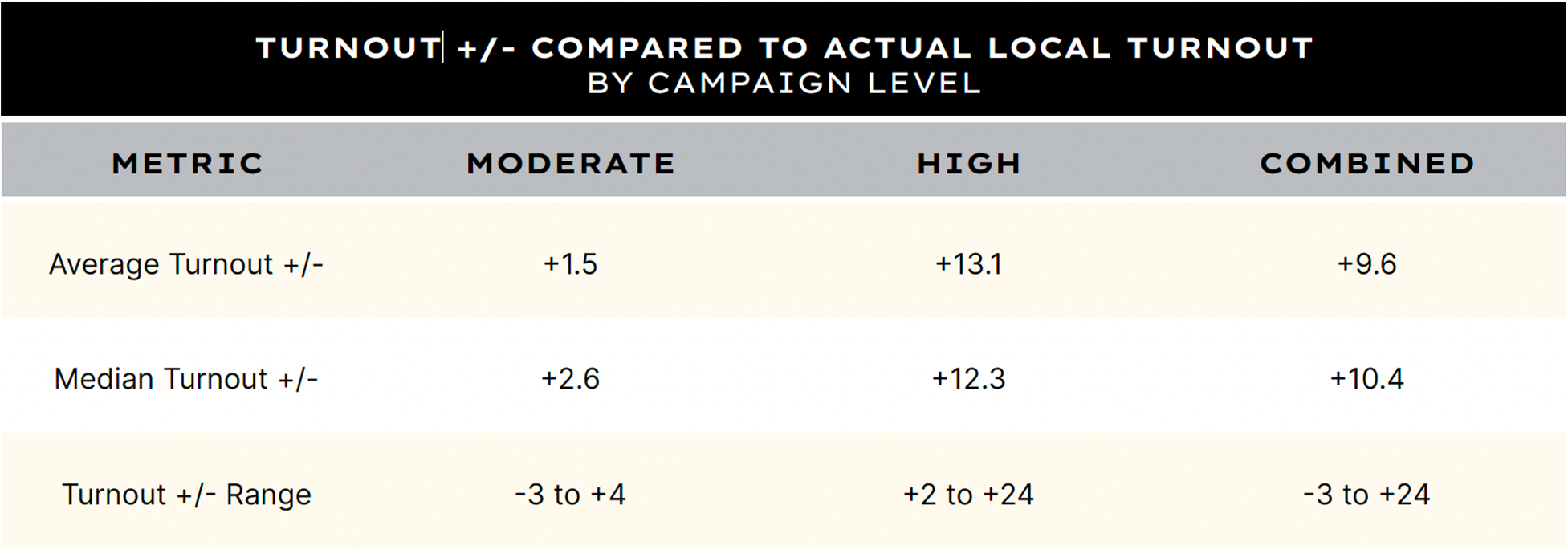
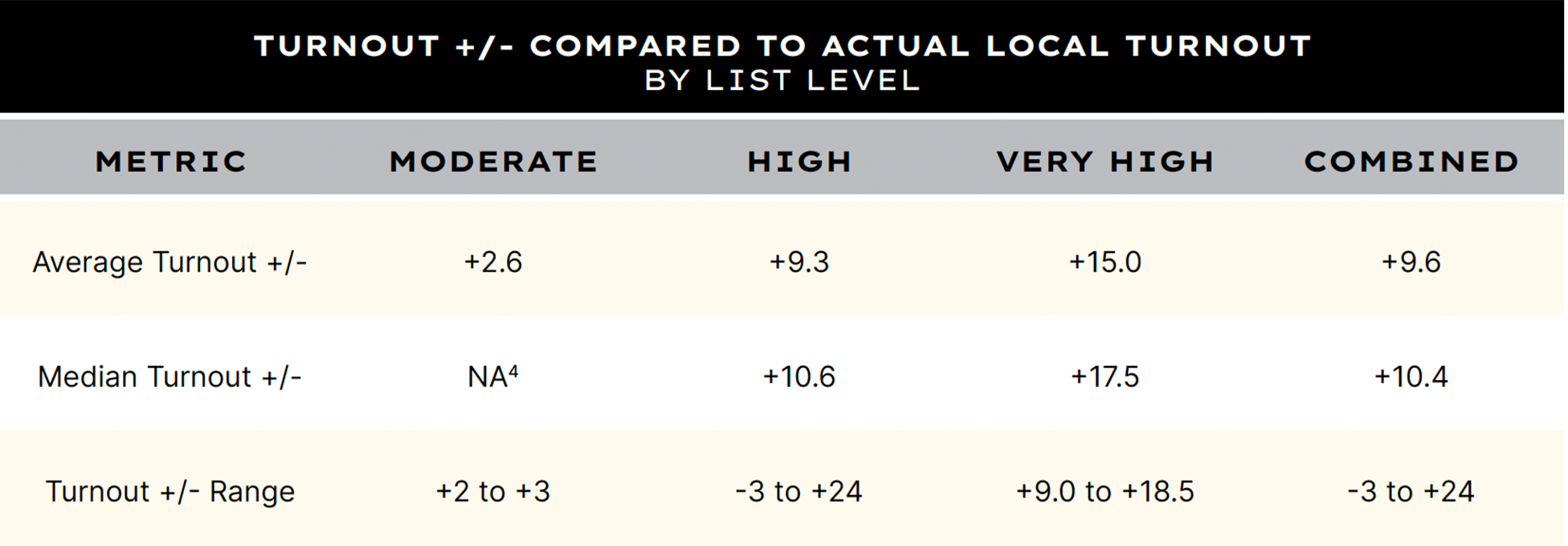
TARGET AUDIENCE TURNOUT COMPARED TO ACTUAL TURNOUT
+/- RANGES BY CAMPAIGN’S LEVEL (TACTICS DEPLOYED)
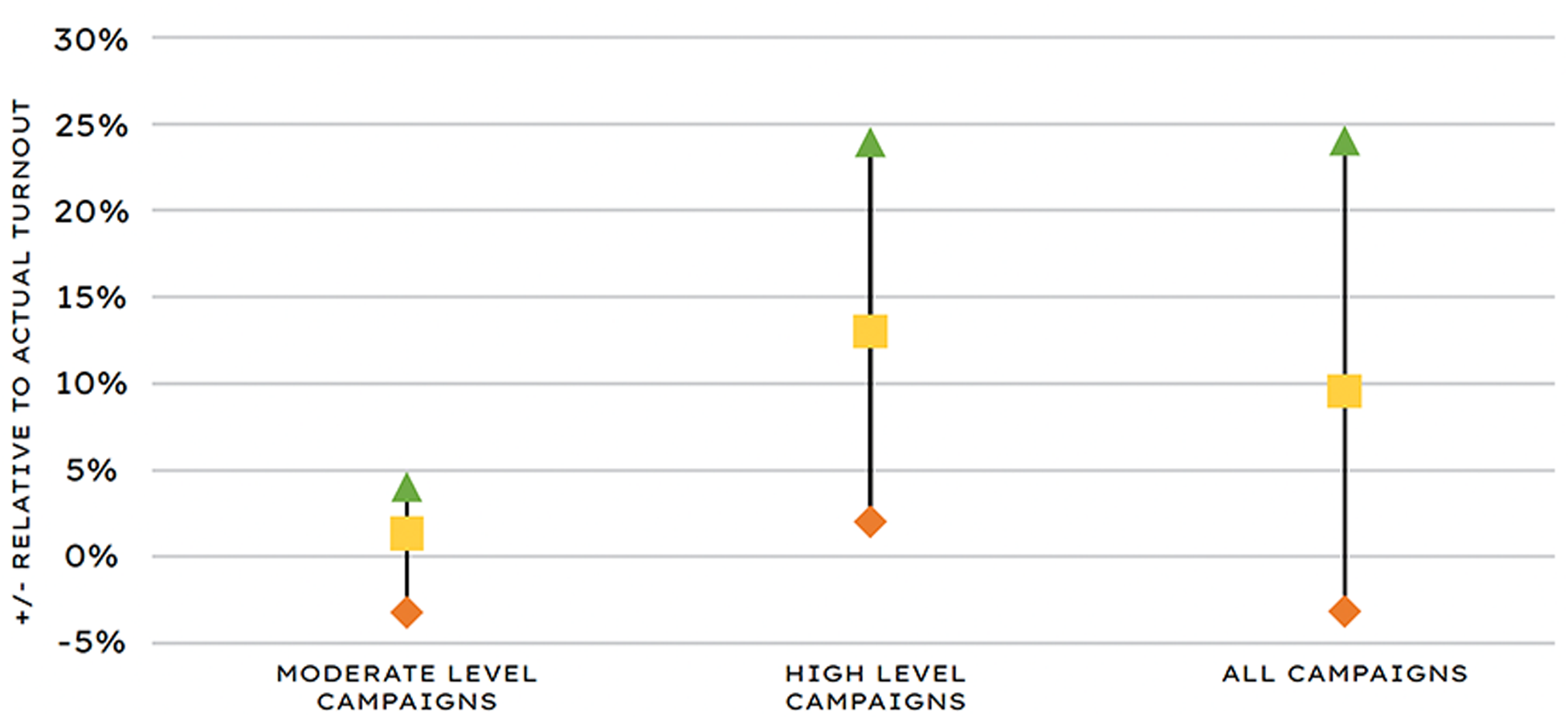
TARGET AUDIENCE TURNOUT COMPARED TO ACTUAL TURNOUT
+/- RANGES BY CAMPAIGN’S LEVEL (TACTICS DEPLOYED)
